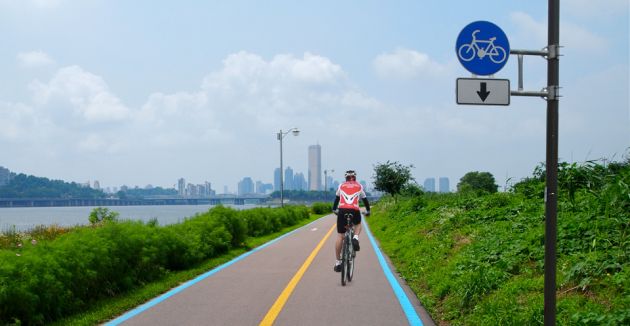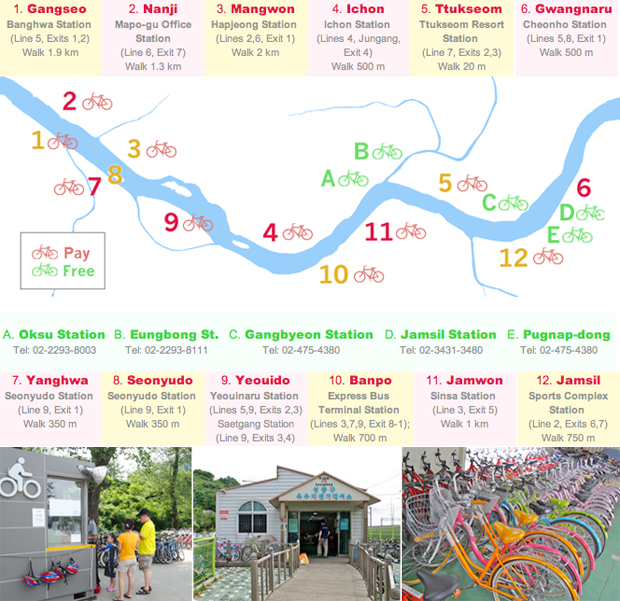Without a doubt, the Hangang (한강), or Han River, is Seoul’s most iconic symbol. The vast waterway – nearly two kilometers wide in places – winds its way from the mountains through the city and out into the Yellow Sea. In the past, frequent flooding kept major development largely away from the riverbanks.

In recent years, Seoul has invested millions of dollars to restore the river ecosystem, improve access to the riverside parks, and to create recreational facilities.
Thanks to these efforts, today there are 12 parks lining about nine million square meters of riverbank are major recreation and relaxation destinations. Even when it’s chilly outside, one of Seoul’s best activities is simply cruising the Hangang on a bicycle!
Via Bike
At my last count, there are 12 bicycle rental kiosks located inside Hangang parks, and for less than $3 per hour, you can rent a bicycle built for one (or a tandem for $6).
To encourage bicycle use, the city has opened another five rental facilities outside subway stations that offer free rentals for up to three hours during the week, or 2 hours on weekends.
Just pre-pay and provide your I.D. or car keys as a “deposit” (see the image for details). There are also a number of other low-cost DIY rental stations popping up around the city.

I’ve personally pedaled almost the entire river on both sides of the river, and what I love about it is the diversity of the parks.
For example, while the Yeouido (여의도) and Banpo (반포) parks feature broad lawns and winding, wide open trails, the Ichon section features a long, narrow stretch lined by tall grasses and dramatic views of Yeouido’s 63 Building.

If you’d like to sample some of Seoul’s wilder areas, head west to Nanji or east to Gwangnaru (광나루). These northwestern and southeastern stretches are less manicured and managed than the central parks.
The Hangang’s Beautiful Bridges
When I moved to Seoul I was told that memorizing the order of the river bridges was a good way to keep my bearings in this impossibly huge city.
That’s easier said than done, since there are 25 bridges spanning the Hangang within the city’s limits, with three more on the way.
Among them, 18 can be crossed on bicycle, and of those, 11 have elevators and/or ramps for easier access. If that wasn’t enough, several have become bicycle destinations in and of themselves.
For example, two lanes each of the Jamsu and Gwangnaru bridges were converted into dedicated bicycle lanes, while eight bridge cafés and two observatories were recently constructed to help draw people to the river.
Other Destinations Along the Way
If you’re looking for things to do other than ride your bike, the riverside park system includes a number of other worthy sites, including the Hangang History Museum (한강역사박물관) on Seonyudo island (선유도) (the island is itself a worthy destination), the curious new J-Bug complex at Ttukseom, and the verdant oasis of Seoul Forest (서울숲) just east of the Jungnangcheon stream (중난천).
Other Activities Along the Way
Lest you think bicycle riding is the only way to enjoy the Hangang, Seoulites have found other ways to enjoy their natural treasure.
Cruising along the Ttukseom (뜩섬) stretch of the Hangang parks, I was amazed to see dozens of windsurfers and kite boarders enjoying the gusts that reliably blow at the river’s bend.
On the far west end of the river, the new Seoul Yachting Association is hoping to add sailboats to the water’s traffic. Add to that the occasional water skier, banana boat riders and, of course, the Hangang pleasure boat cruises that slowly ply their way along the river.

Be it for the natural beauty, the exercise or simply the fun of cruising along the Hangang, why not try your next sightseeing excursion by cruising the Hangang on a bicycle?
For your information…
| Open: | The Hangang parks are open 24 hours. |
| Admission Price: | Free. Bicycle rentals are usually 3,000 won per hour. |
| Address: | Several locations along both sides of the river. |
| Directions: | The Hangang parks can be accessed via several Seoul Metro stations. They include: – Reach Ttukseom via Ttukseom Resort Station on Line 7, exits 2-3. – Reach Yeouido via Yeouinaru Station on Lines 5 + 9, exits 3-4. – Reach Yanghwa and Seonyudo Is. via Seonyudo Station on Line 9, exit 1. |
| Phone: | 02-1330 |
About Matt Kelley
Matt Kelly is native of the US Pacific Northwest and is half-Korean by ethnicity. He lived in Korea for five years and has written hundreds of travel guides for Wallpaper, TimeOut, the Boston Globe and Seoul Magazine and was a host for several different variety shows on Korean radio and television.
